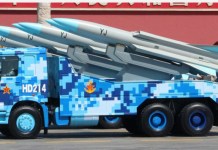The Indian and Pakistani armies have been fighting a “No-Win” war on the 20,000-foot-high Siachen Glacier, the world’s highest battleground. The glacier is on the northern tip of the Line of Control that divides India and Pakistan-administered Kashmir.
Pakistan Reportedly Closes 13 Terror Training Camps Near Jammu and Kashmir
The two countries, which claim the Kashmir region in full, have deployed troops at Siachen. Temperatures fall to 60 degrees below zero, and sudden blizzards bury field artillery in minutes. Only 10 per cent of oxygen is available in Siachen than it is in plains.
Snowstorms on the Siachen glacier can last for as long as 3 weeks where winds can touch speeds of 100 mph in no time. Annual snowfall in Siachen can be well over 3 dozen feet. Soldiers are at the risk of getting frostbite if their bare skin touches any metal object for more than 15 seconds. Fainting spells and pounding headaches are frequent.
The region has witnessed intermittent skirmishes for decades, but more soldiers have died from the harsh weather than combat at the world’s highest battlefield. In 2017, at least 24 people, including 20 soldiers, were killed in a series of avalanches, while in 2012, a massive avalanche in Pakistani-administered Kashmir killed 140 people, including 129 Pakistani soldiers.
Easter Sunday Bombings – Sri-Lanka Could Seek Pakistan’s Help To Trace & Hunt Terrorists
Soldiers who stay at that altitude for long suffer from weight loss, loss of appetite, sleep disorders and memory loss. Speech blurring is obvious. Rations come out of tin cans. An orange or an apple can freeze to the hardness of a cricket ball in no time. Army pilots literally push their helicopters well beyond their optimal performance, to drop supplies at forward posts located at an altitude of more than 20,000 feet.
At Siachen, the Indian Army spends as much as 80 per cent of its time preparing soldiers of deployment. Official data shows that climatic conditions take an average of 10 Indian lives a year on the glacier. And according to official Pakistani Army data, its army has been losing an average of 30 soldiers a year in the same sector, since 2003.
Yet, soldiers have been for almost three decades now continuously manning impossible posts at heights of over 20,000 feet, climbing up and down the receding glacier on foot and landing choppers at altitudes they were not even designed to fly.
While Everyone Looks at Syria, US Prepares for War in Europe
Apart from serving in the world’s most challenging terrain, a report of the Indian Comptroller and Auditor General (CAG) has emerged which highlights the grim realities that Indian Troops encounter while serving in Siachen and Ladakh.
The Indian Army troops, as per CAG, do not have snow glasses and multi-purpose boots to wear and are even deprived of the sanctioned daily consumption of food.
The CAG tabled the report on Union Government (Defence Services)-Army in the Rajya Sabha but failed to lay it in the Lok Sabha. News agency IANS, quoting sources in the Rajya Sabha, reports that the audit highlights the condition of Indian Army in high altitude areas.
According to the CAG report, the troops stationed at high altitude areas are given old versions of face masks, jackets and sleeping bags. It says the calorie intake of the troops is compromised as high as 82%. The shortage of snow goggles—between 62 per cent and 98 per cent—exposes soldiers’ faces and eyes to extreme weather, as per the report.




